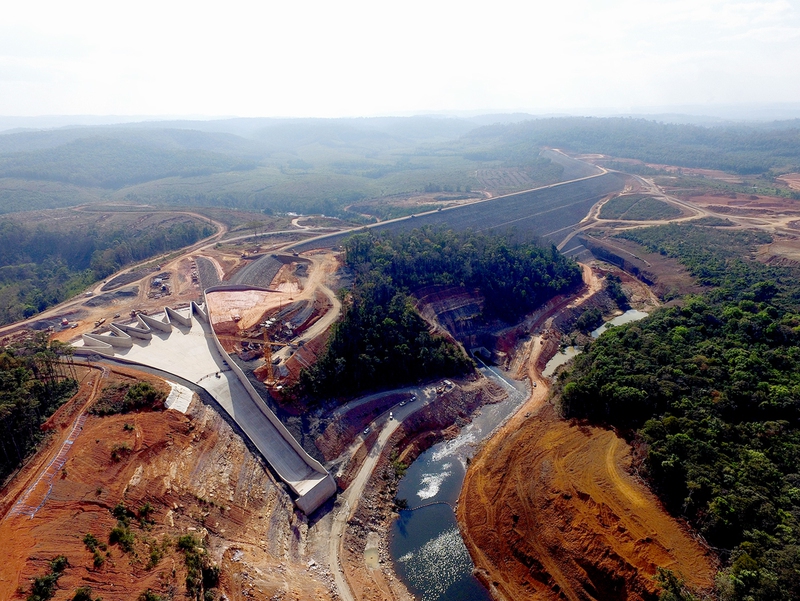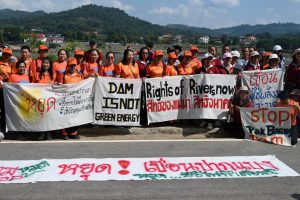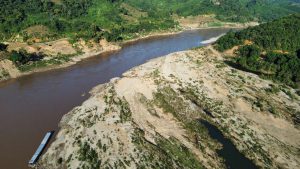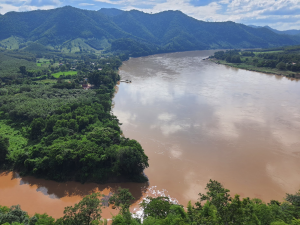SK E&C attempted to earn excessive profits with changes to the format and design of a dam in Laos that eventually collapsed last July, an internal document confirmed on Oct. 14. Indeed, the heights of the collapsed dam and other auxiliary dams handled by SK E&C were an average of 6.5m lower than in the basic design diagrams included in the document.Observers also noted that while the project was an official development assistance (ODA) project with government funding, support was provided without a National Assembly budget review – suggesting the government acted irresponsibly to provide profits to SK E&C.
“Cut construction costs through changes to building materials”
An SK E&C document from Nov. 2012 titled “Laos Dam Project Implementation Plan” acquired by the Hankyoreh that day through Democratic Party lawmaker Kim Kyung-hyup indicated that the company’s authority to alter the existing design was used to obtain “maintenance costs and profits” amounting to up to 15 percent of construction costs (US$102 million).
In August of the same year, SK E&C reached an agreement with PNPC – the joint venture in charge of the Laos dam’s development – guaranteeing maintenance costs and profits amounting to 12.2 percent of construction costs (US$83 million).SK E&C then proceeded to develop a “detailed plan” to generate more profits. The document acquired by Kim made reference to cutting US$19 million in construction costs through alterations to the dam’s format and materials and adjustments to its slope, as well as delaying the scheduled April 2013 start of construction to pressure other investors into covering financial costs and secure an advantage in negotiations on incentive bonuses for completion ahead of schedule.
Average auxiliary dam height lowered by 6.5mMost notably, design changes resulted in dam heights being lowered according to the detailed plans to increase profitability. The heights of the five auxiliary dams included in the SK E&C document’s basic design plan measured between 10 and 25 meters. But in the additional plan submitted to Kim’s office as having actually been followed by SK E&C, the dam heights ranged between 3.5 and 18.6 meters.
The heights of the auxiliary dams had been lowered by an average of 6.5m from the basic design plan.The problem is that the project was not simply a private for-profit effort, but received ODA funds from the South Korean government. In 2011, the Laotian government requested loan assistance from the South Korean government for the building of dams. On the basis of that request, the joint venture PNPC was formed by SK E&C, Korea Western Power, Thailand’s Ratchaburi, and the state-run Lao State Holding Enterprise.The project was pursued as an ODA project, but Export-Import Bank of Korea funding was not provided as civic group raised concerns about environmental destruction.
In May 2015, the Ministry of Strategy and Finance abruptly designed to provide loan support for four projects, including dam-building in Laos.The following October, the Laos dam project was adopted to a list of Economic Development Cooperation Found projects; around 68.7 billion won (US$60.7 million) was quickly provided to the Laotian government that December.
The money was given while omitting the necessary procedures for ODA projects, which include a year-end National Assembly budget review and an international development cooperation committee project review according to the Framework Act on International Development Cooperation.All three of the other projects receiving loan support beside the Laos dams received National Assembly budget reviews.Regarding the design changes to maximize profits, SK E&C reportedly told Kim’s office that the project “did not proceed according to the plan stated in the document, with actual maintenance fees and profits of under 10 percent” and that “the [original] basic design for the auxiliary dam must not have been seen as that important because it was not the main construction effort.”
Kim called the Laos dam collapse an “all-around man-made disaster spawned by SK E&C’s desire to generate excessive profits by altering the very design and the last administration, which disregarded procedure in disbursing the loan.”
By Seo Young-ji, staff reporter
ที่มา https://bit.ly/2LPZ0Mt




